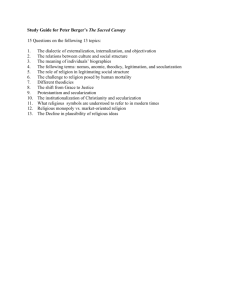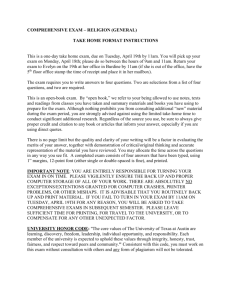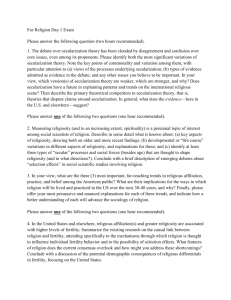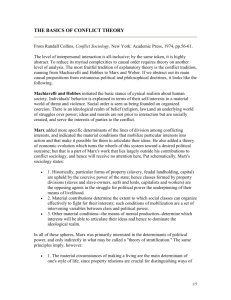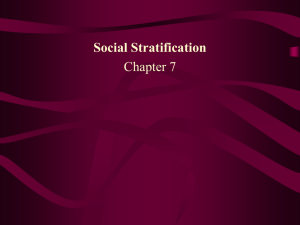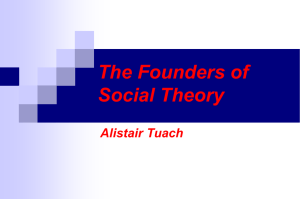Chapter 12
advertisement
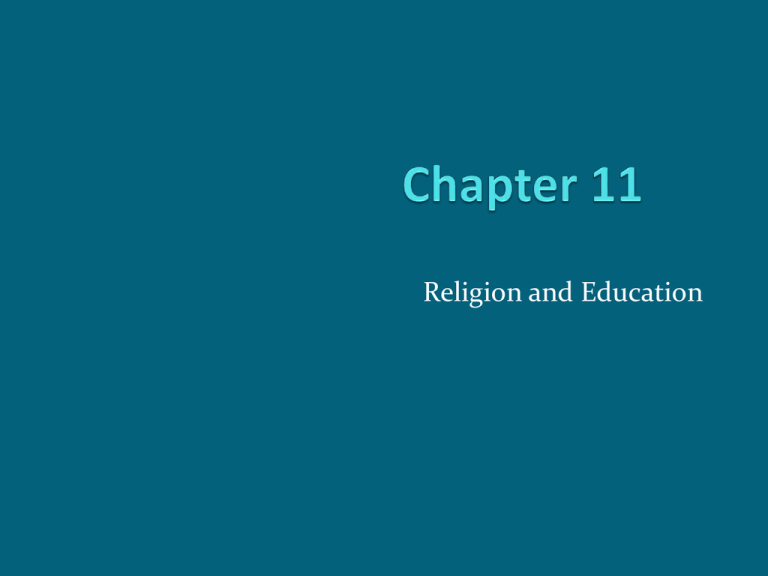
Religion and Education Chapter ClassicalOutline Approaches in the Sociology of Religion The Rise, Decline, and Partial Revival of Religion The Structure of Religion in the world Religiosity Education Macrosociological Processes Microsociological Processes Durkheim’s Functionalist Approach to Religion According to Durkheim, when people live together, they share common sentiments and values. These form a collective conscience that is larger than any individual. When we experience the collective conscience directly, we can distinguish the profane from the sacred. Durkheim’s Theory of Religion We designate certain objects as symbolizing the sacred, these are totems. We invent public practices to connect us with the sacred, these are called rituals. The function of rituals and of religion as a whole is to reinforce social solidarity. Durkheim’s Theory and the Super Bowl Durkheim would consider the Super Bowl trophy and the team logo to be totems. The game itself is a public ritual. The game is a sacred event in Durkheim’s terms because it increases social solidarity and cements society. Conflict and Feminist Critiques of Durkheim 1. 2. Overemphasizes religion’s role in maintaining social cohesion, when religion often incites social conflict. Ignores the fact that when religion increases social cohesion, it often reinforces social inequality. The World’s Predominant Religions Weber: Routinization of Charisma Weber’s term for the transformation of the unique gift of divine enlightenment into a permanent feature of everyday life. It involves turning religious inspiration into a stable social institution with defined roles (interpreters of the divine message, teachers, dues-paying laypeople, etc.). Civil Religion A set of beliefs and practices that bind a population together and justify its way of life. Weber: A Symbolic Interactionist Interpretation For Weber, a combination of factors prompted capitalist development in non-Catholic Europe and North America: favorable economic conditions the spread of certain moral values by the Protestant reformers of the 16th century and their followers. Weber and the Protestant Ethic Weber wrote that followers of Protestant theologian Calvin stressed the need to display industry, punctuality, and frugality. People could assure a state of grace by working diligently and living simply. In contrast, Buddhism and Confucianism hindered worldly success in competition and capital accumulation. Secularization Thesis of Religion Religious institutions, actions, and consciousness are on the decline. Critics: There has been a religious revival in the U.S. over the past 30 years. Survey evidence shows religion in the U.S. is resilient. Fundamentalists Interpret scriptures literally. Seek to establish a direct, personal relationship with the higher being(s) they worship. Are relatively intolerant of nonfundamentalists. Often support conservative social issues. Revised Secularization Thesis Holds that worldly institutions break off from the institution of religion over time. As a result, religion governs an ever smaller part of most people’s lives and becomes largely a matter of personal choice. Perceived Adequacy of the Church INSERT FIGURE 11.2 HERE (PG. 264) Market Model of Religion Religious organizations are suppliers of services (e.g., counseling, pastoral care, youth activities) and people who desire religions activities demand such services Religious denominations are similar to product brands offering different “flavors” of religious experiences Percent Who Think Religion Is Very Important, 44 Countries Revised Secularization and Market Theories of Religion INSERT CONCEPT SUMMARY 11.1 HERE (PG. 265) Polling Question Do you believe that the Bible is the actual word of God, to be taken literally word for word? a. b. Yes No Types of Religious Organization Church: bureaucratic religious organization that has accommodated itself to mainstream society and culture Ecclesia: state-supported churches Denominations: various streams of belief and practice that can coexist under overarching authority Types of Religious Organizations, cont. Sects: form by breaking away from churches as a result of disagreement about church doctrine Cults: small groups of people deeply committed to a religious vision that rejects mainstream culture and society Religion Affiliation, U.S. 2007 INSERT FIGURE 11.4 HERE (PG. 266) Polling Question What is your current religious affiliation? a. b. c. d. e. Protestant Catholic Jewish None Other Religious Affiliation by Annual Income INSERT FIGURE 11.5 HERE (PG. 267) Religiosity Refers to how important religion is to people People over age 69 attend much more frequently More time and more need for religion African Americans attend much more frequently Political and cultural role church played in helping African Americans cope and combat slavery Religiosity, cont. More likely to attend when mothers and fathers attended religious services Religiosity is a learned behavior Factors Influencing How Often Americans Attend Religious Services INSERT TABLE 11.1 HERE (PG. 268) Education Instead of religion, education is the dominant institution of socialization outside of the family A central determinant of opportunities for upward mobility Advocates of Affirmative Action: Compensates for historical injustices such as slavery and expulsion. Helps create a level playing field for all races and ethnic groups. Encourages diversity on college campuses. Creates a middle-class leadership group in minority communities. Opponents of Affirmative Action: We should not have to pay for wrongs committed 300 years ago. Note that colleges apply affirmative action criteria to rich and poor members of selected minority groups. Meritocracy A stratification system in which equality of opportunity allows people to rise or fall to a position that matches their talent and effort. Functional Theory of Education Manifest (intended) functions of schools: Sorting students based on talent and effort Train and socialize students. Create social cohesion. Transmit culture from generation to generation. Sort students, presumably by merit. Functional Theory of Education, cont. Latent (unintended) functions of schools: Create a youth culture and a marriage market. Create a custodial and surveillance system for children. Maintain wage levels by keeping students out of the job market. Occasionally becoming a “school of dissent” that opposes authorities. Polling Question How far do you intend to go in school? a. b. c. d. e. Two years of college Four years of college Master's degree Professional degree (law, medicine, dentistry) Ph.D. Conflict Theories of Education Effects of Economic Inequality on Education: Schools of widely differing quality. Families with varying access to resources for the support of children. Children enter school with differing levels of preparation and eagerness to learn. Standardized Tests Standardized tests help reproduce the existing system of social stratification. Schools use tracking to sort students into highability, middle-ability, and low-ability classes based on the results of intelligence-quotient (IQ) and other tests. How Social Background and IQ Influence Inequality Gender and Education: Feminist Contribution In some ways, women are doing better than men in the American education system Yet, still see disadvantages for women when we examine: field of study (high-paying vs. low-paying fields) and level of degree (Ph.D.s for men) Symbolic Interactionist Theory of Education Stereotype Threat: Refers to the harmful impact of negative stereotypes on the school performance of disadvantaged groups. Polling Question What is the highest level of education completed by your father? a. b. c. d. e. f. Below high school High school graduate Some college or postsecondary training College degree Graduate or professional degree Don't know Major Reforms Proposed for American Schools Mentoring Redistributing and increasing school budgets. Substantially improving the social environment of young, disadvantaged children before and outside school. 1. The sacred refers to: a. b. c. d. sentiments and values people share the secular, everyday world the religious, transcendent world public practices designed to connect people to the transcendent world Answer: c The sacred refers to the religious, transcendent world. 2. Which of the following is a criticism frequently lodged against Durkheim's theory of religion? a. b. c. d. Religion often heightens the sense of belonging to certain groups. Religion often incites social conflict. Religion often reinforces social inequality. Religion often incites social conflict, and religion often reinforces social inequality Answer: d The ideas that religion often incites social conflict, and religion often reinforces social inequality are criticisms frequently lodged against Durkheim's theory of religion. 3. A civil religion is: a. b. c. d. a religion that encourages its members to participate actively in the political arena a religion that does not discriminate on the basis of race, class, gender, or sexual orientation a religion that contributes to social change a set of quasi-religious beliefs and practices that binds the population and justifies its way of life Answer: d A civil religion is a set of quasi-religious beliefs and practices that binds the population and justifies its way of life. 4. Weber recognized: a. b. c. d. importance of the economic factor in explaining of capitalism one-sidedness of any exclusively economic interpretation of the rise of capitalism role of certain Protestant moral values in stimulating the rise of capitalism in Western Europe and North America b. and c. Answer: d Weber recognized the one-sidedness of any exclusively economic interpretation of the rise of capitalism and the role of certain Protestant moral values in stimulating the rise of capitalism in Western Europe and North America. 5. According to the secularization thesis: a. b. c. d. religious institutions, actions, and conscious are on the decline worldwide religious institutions will disappear in the near future religiosity is negatively correlated with level of economic development Communist governments, which promoted atheism, lowered the level of religiosity in their countries0 Answer : a According to the secularization thesis: religious institutions, actions, and conscious are on the decline worldwide. 6. Which of the following is not a characteristic of a cult? a. b. c. d. Cults are groups of people committed to a religious vision that rejects mainstream culture and society. Cults are generally led by charismatic individuals. Cults tend to recruit members from all segments of the stratification system. Cults tend to disappear after a relatively short period of time. Answer: c The following is not a characteristic of a cult: Cults tend to recruit members from all segments of the stratification system. 7. The routinization of charisma is Weber's term for the transformation of divine enlightenment into a permanent feature of everyday life. a. True b. False Answer: a The routinization of charisma is Weber's term for the transformation of divine enlightenment into a permanent feature of everyday life. 8. Revised secularization thesis focuses on: a. b. c. d. “re-enchantment” of the world restriction of religion to just the spiritual part of people’s lives the way religion has become a personal matter rather than one imposed by institutions all of these choices Answer: b The revised secularization thesis focuses on the restriction of religion to just the spiritual part of people’s lives. 9. Affirmative action in college admissions refers to the practice of: a. b. c. d. offering of financial support to students from poor backgrounds giving preference to students who have a parent who graduated from the college to which they are applying giving preference to applicants from minority groups all of these choices Answer : c Affirmative action in college admissions refers to the practice of giving preference to applicants from minority groups. 10. Advocates of affirmative action say: a. b. c. d. it compensates for historical injustices such as slavery and expulsion it enriches college campuses by encouraging racial and ethnic diversity it creates a middle-class leadership group in minority communities all of these choices Answer: d Advocates of affirmative action say: it compensates for historical injustices such as slavery and expulsion, it enriches college campuses by encouraging racial and ethnic diversity and it creates a middle-class leadership group in minority communities. 11. Which of the following is a latent function that schools accomplish unintentionally? a. b. c. serving as a "marriage market" by bringing potential mates together keeping children under surveillance and freeing parents to work both of these choices Answer : c Serving as a "marriage market" by bringing potential mates together and keeping children under surveillance and freeing parents to work are latent functions that schools accomplish unintentionally. 12. IQ tests measure: a. b. c. d. underlying social stratification genetic endowment credential inflation a. and b. only Answer: d IQ tests measure underlying social stratification and genetic endowment. 13. Self-fulfilling prophecies in the educational system: a. b. c. d. e. reinforce background factors reduce background factors reproduce existing patterns of inequality none of these choices reinforce the effects of background factors, and help reproduce existing patterns of inequality Answer: e Self-fulfilling prophecies in the educational system reinforce the effects of background factors, and help reproduce existing patterns of inequality.


